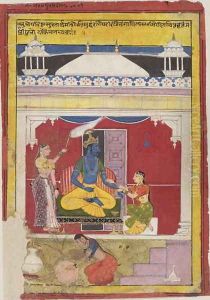Sahibdin Paintings
Sahibdin was an Indian painter who flourished in the early 17th century, primarily known for his work in the Mewar school of Indian miniature painting. His exact date of birth is not recorded, but he was active during the reign of Maharana Jagat Singh I of Mewar, who ruled from 1628 to 1652. Sahibdin's work is a significant part of the Rajasthani school of painting, which was characterized by its bold use of color, emphasis on devotion, and the depiction of scenes from Hindu epics, love poems, and the life of Krishna.
Sahibdin's painting style combined indigenous Indian art traditions with the influences of the Mughal school, which had become prominent in India following the Mughal conquest. The Mughal influence is evident in the refined elegance, naturalistic detail, and use of perspective in his work. However, Sahibdin maintained a distinctly Rajasthani palette, with bright colors and a strong narrative element that was aligned with local tastes and spiritual traditions.
One of Sahibdin's most famous works is the 'Razmnama' (Book of War), which is a Persian translation of the great Hindu epic, the Mahabharata, commissioned by the Mughal emperor Akbar in the 16th century. Sahibdin was responsible for illustrating a copy of the 'Razmnama' in the 1640s, which showcased his mastery in depicting complex battle scenes and royal processions.
Sahibdin's legacy is marked by his contribution to the Mewar school's body of work and his role in blending Mughal and Rajasthani artistic elements. His paintings are still studied for their technique and historical value, and original works by Sahibdin are considered highly valuable by collectors and institutions specializing in Indian art. While the precise date of his death is uncertain, it is believed that he died around 1660. Sahibdin's art remains an important window into the cultural and religious life of 17th-century India, reflecting the syncretic nature of its society.
